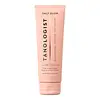bondi sands Everyday Gradual Tanning Milk Versus Tanologist Daily Glow Brightening Gradual Tan Lotion
What's inside
What's inside
 Key Ingredients
Key Ingredients

 Benefits
Benefits

 Concerns
Concerns

 Ingredients Side-by-side
Ingredients Side-by-side

Water
Skin ConditioningAloe Barbadensis Leaf Juice
Skin ConditioningIsopropyl Palmitate
EmollientBis-PEG-18 Methyl Ether Dimethyl Silane
EmollientCocoglycerides
EmollientDihydroxyacetone
Skin ConditioningButyrospermum Parkii Butter
Skin ConditioningGlyceryl Stearate
EmollientPolyacrylamide
Phenoxyethanol
PreservativeMethylparaben
PreservativeC13-14 Isoparaffin
EmollientTocopheryl Acetate
AntioxidantErythrulose
TanningParfum
MaskingPropylparaben
PreservativeLaureth-7
EmulsifyingCetyl Phosphate
EmulsifyingButylparaben
MaskingEthylparaben
PreservativeTriethanolamine
BufferingWater, Aloe Barbadensis Leaf Juice, Isopropyl Palmitate, Bis-PEG-18 Methyl Ether Dimethyl Silane, Cocoglycerides, Dihydroxyacetone, Butyrospermum Parkii Butter, Glyceryl Stearate, Polyacrylamide, Phenoxyethanol, Methylparaben, C13-14 Isoparaffin, Tocopheryl Acetate, Erythrulose, Parfum, Propylparaben, Laureth-7, Cetyl Phosphate, Butylparaben, Ethylparaben, Triethanolamine
Water
Skin ConditioningDimethicone
EmollientDihydroxyacetone
Skin ConditioningIsopropyl Myristate
EmollientPhenyl Trimethicone
Skin ConditioningNiacinamide
SmoothingMalpighia Punicifolia Fruit Extract
AntioxidantPrunus Serrulata Flower Extract
Skin ConditioningPrunus Amygdalus Dulcis Oil
Skin ConditioningAscorbic Acid
AntioxidantHelianthus Annuus Seed Oil
EmollientGlycerin
HumectantCetearyl Alcohol
EmollientCaprylic/Capric Triglyceride
MaskingParfum
MaskingBenzyl Salicylate
PerfumingLimonene
PerfumingPEG-100 Stearate
Glyceryl Stearate
EmollientTocopheryl Acetate
AntioxidantIsohexadecane
EmollientSorbitan Isostearate
EmulsifyingPolysorbate 60
EmulsifyingHydroxyethyl Acrylate/Sodium Acryloyldimethyl Taurate Copolymer
Emulsion StabilisingPhenoxyethanol
PreservativeTriethylene Glycol
MaskingWater, Dimethicone, Dihydroxyacetone, Isopropyl Myristate, Phenyl Trimethicone, Niacinamide, Malpighia Punicifolia Fruit Extract, Prunus Serrulata Flower Extract, Prunus Amygdalus Dulcis Oil, Ascorbic Acid, Helianthus Annuus Seed Oil, Glycerin, Cetearyl Alcohol, Caprylic/Capric Triglyceride, Parfum, Benzyl Salicylate, Limonene, PEG-100 Stearate, Glyceryl Stearate, Tocopheryl Acetate, Isohexadecane, Sorbitan Isostearate, Polysorbate 60, Hydroxyethyl Acrylate/Sodium Acryloyldimethyl Taurate Copolymer, Phenoxyethanol, Triethylene Glycol
Ingredients Explained
These ingredients are found in both products.
Ingredients higher up in an ingredient list are typically present in a larger amount.
Dihydroxyacetone, or DHA, is a simple sugar. It is frequently used in self-tanning products.
DHA binds to the amino acids in your dead skin cells to create a brown/orange color. Darkening begins to kick in a few hours after application and will continue to develop for up to 3 days. This ingredient can be drying.
Both the US and the EU have approved DHA in self-tanning products. In the EU, DHA is allowed at a maximum concentration of 10%. Most tanning products usually contain amounts between 3-5%.
If you are pregnant or have underlying medical conditions, it is best to speak with a dermatologist about using self-tanning products.
Learn more about DihydroxyacetoneGlyceryl Stearate is a mix of glycerin and stearic acid.
It is used to stabilize the mixing of water and oil ingredients. By preventing these ingredients from separating, it can help elongate shelf life. It can also help thicken the product's texture.
As an emollient, it helps soften skin and supports barrier-replenishing ingredients.
In cosmetics, Glyceryl Stearate is often made from vegetable oils or synthetically produced.
This ingredient may not be fungal-acne safe
Fun fact: The human body also creates Glyceryl Stearate naturally.
Learn more about Glyceryl StearateParfum is a catch-all term for an ingredient or more that is used to give a scent to products.
Also called "fragrance", this ingredient can be a blend of hundreds of chemicals or plant oils. This means every product with "fragrance" or "parfum" in the ingredients list is a different mixture.
For instance, Habanolide is a proprietary trade name for a specific aroma chemical. When used as a fragrance ingredient in cosmetics, most aroma chemicals fall under the broad labeling category of “FRAGRANCE” or “PARFUM” according to EU and US regulations.
The term 'parfum' or 'fragrance' is not regulated in many countries. In many cases, it is up to the brand to define this term.
For instance, many brands choose to label themselves as "fragrance-free" because they are not using synthetic fragrances. However, their products may still contain ingredients such as essential oils that are considered a fragrance by INCI standards.
One example is Calendula flower extract. Calendula is an essential oil that still imparts a scent or 'fragrance'.
Depending on the blend, the ingredients in the mixture can cause allergies and sensitivities on the skin. Some ingredients that are known EU allergens include linalool and citronellol.
Parfum can also be used to mask or cover an unpleasant scent.
The bottom line is: not all fragrances/parfum/ingredients are created equally. If you are worried about fragrances, we recommend taking a closer look at an ingredient. And of course, we always recommend speaking with a professional.
Learn more about ParfumPhenoxyethanol is a preservative that has germicide, antimicrobial, and aromatic properties. Studies show that phenoxyethanol can prevent microbial growth. By itself, it has a scent that is similar to that of a rose.
It's often used in formulations along with Caprylyl Glycol to preserve the shelf life of products.
Tocopheryl Acetate is AKA Vitamin E. It is an antioxidant and protects your skin from free radicals. Free radicals damage the skin by breaking down collagen.
One study found using Tocopheryl Acetate with Vitamin C decreased the number of sunburned cells.
Tocopheryl Acetate is commonly found in both skincare and dietary supplements.
Learn more about Tocopheryl AcetateWater. It's the most common cosmetic ingredient of all. You'll usually see it at the top of ingredient lists, meaning that it makes up the largest part of the product.
So why is it so popular? Water most often acts as a solvent - this means that it helps dissolve other ingredients into the formulation.
You'll also recognize water as that liquid we all need to stay alive. If you see this, drink a glass of water. Stay hydrated!
Learn more about Water